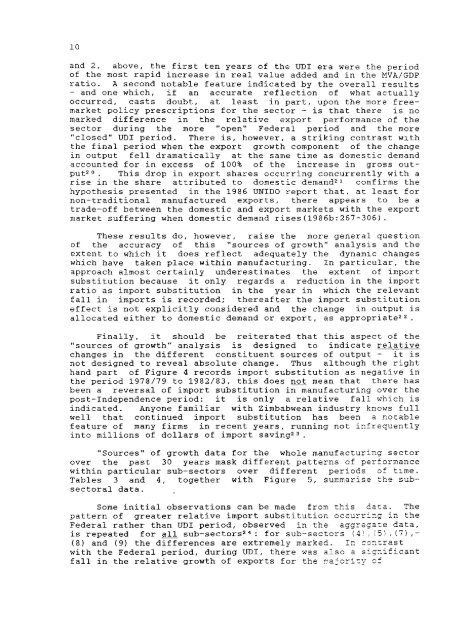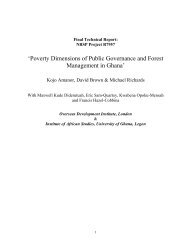Zimbabwe - Overseas Development Institute
Zimbabwe - Overseas Development Institute
Zimbabwe - Overseas Development Institute
You also want an ePaper? Increase the reach of your titles
YUMPU automatically turns print PDFs into web optimized ePapers that Google loves.
and 2, above, the f i r s t ten years of the UDI era were the period<br />
of the most r a p i d increase i n r e a l value added and i n the MVA/GDP<br />
r a t i o . A second notable feature i n d i c a t e d by the o v e r a l l r e s u l t s<br />
- and one which, i f an accurate r e f l e c t i o n of what a c t u a l l y<br />
occurred, casts doubt, at l e a s t i n part, upon the more f r e e -<br />
market p o l i c y p r e s c r i p t i o n s f o r the sector - i s that there i s no<br />
marked d i f f e r e n c e i n the r e l a t i v e export performance of the<br />
sector during the more "open" Federal period and the more<br />
"closed" UDI period. There i s , however, a s t r i k i n g contrast with<br />
the f i n a l period when the export growth component of the change<br />
i n output f e l l d r a m a t i c a l l y at the same time as domestic demand<br />
accounted f o r i n excess of 100% of the increase i n gross output^".<br />
This drop i n export shares o c c u r r i n g concurrently with a<br />
r i s e i n the share a t t r i b u t e d to domestic demand^i confirms the<br />
hypothesis presented i n the 1986 UNIDO report that, at l e a s t f o r<br />
n o n - t r a d i t i o n a l manufactured exports, there appears to be a<br />
trade-off between the domestic and export markets with the export<br />
market s u f f e r i n g when domestic demand r i s e s (1986b:267-306) .<br />
These r e s u l t s do, however, r a i s e the more general question<br />
of the accuracy of t h i s "sources of growth" a n a l y s i s and the<br />
extent to which i t does r e f l e c t adequately the dynamic changes<br />
which have taken place w i t h i n manufacturing. In p a r t i c u l a r , the<br />
approach almost c e r t a i n l y underestimates the extent of import<br />
s u b s t i t u t i o n because i t only regards a reduction i n the import<br />
r a t i o as import s u b s t i t u t i o n i n the year i n which the relevant<br />
f a l l i n imports i s recorded; t h e r e a f t e r the import s u b s t i t u t i o n<br />
e f f e c t i s not e x p l i c i t l y considered and the change i n output i s<br />
a l l o c a t e d e i t h e r to domestic demand or export, as appropriate^^ _<br />
F i n a l l y , i t should be r e i t e r a t e d that t h i s aspect of the<br />
"sources of growth" a n a l y s i s i s designed to i n d i c a t e r e l a t i v e<br />
changes i n the d i f f e r e n t c o n s t i t u e n t sources of output - i t i s<br />
not designed to reveal absolute change. Thus although the r i g h t<br />
hand part of Figure 4 records import s u b s t i t u t i o n as negative i n<br />
the period 1978/79 to 1982/83, t h i s does not mean that there has<br />
been a r e v e r s a l of import s u b s t i t u t i o n i n manufacturing over the<br />
post-Independence period: i t i s only a r e l a t i v e f a l l which i s<br />
i n d i c a t e d . Anyone f a m i l i a r with <strong>Zimbabwe</strong>an i n d u s t r y knows f u l l<br />
w e l l that continued import s u b s t i t u t i o n has been a notable<br />
feature of many firms i n recent years, running not i n f r e q u e n t l y<br />
i n t o m i l l i o n s of d o l l a r s of import saving^^.<br />
"Sources" of growth data f o r the whole manufacturing sector<br />
over the past 30 years mask d i f f e r e n t patterns of performance<br />
w i t h i n p a r t i c u l a r sub-sectors over d i f f e r e n t periods of time.<br />
Tables 3 and 4, together with Figure 5, summarise the subs<br />
e c t o r a l data.<br />
Some i n i t i a l observations can be made from t h i s data. The<br />
pattern of greater r e l a t i v e import s u b s t i t u t i o n occurring i n the<br />
Federal rather than UDI period, observed i n the aggregate data,<br />
i s repeated f o r a l l sub-sectors^ •> : for sub-sectors { 4 ) , ( 5) , (7 ) ,-<br />
(8) and (9) the d i f f e r e n c e s are extremely marked. Ir. contrast<br />
with the Federal period, during UDI, there was also a s i g n i f i c a n t<br />
f a l l i n the r e l a t i v e growth of exports f o r the r a j o r i t y cf
















